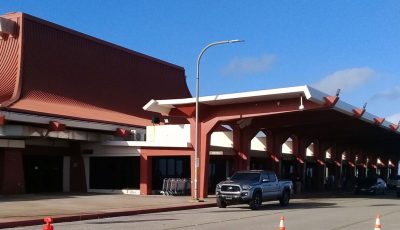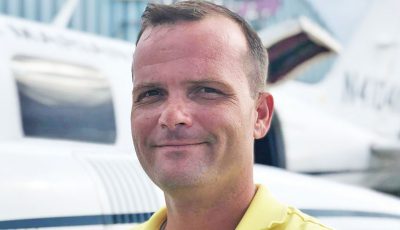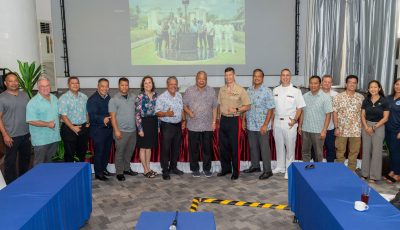FAA to look into ‘near-collision’
Star Marianas reports more ‘unannounced’ military approaches mid-air
The Federal Aviation Administration will look into the “near-miss” between civilian and military aircraft last Wednesday afternoon, when two unidentified military C-130s came directly at and passed unannounced within 300 feet of a Star Marianas twin-engine plane.
“We are presently collecting the necessary data to conduct an investigation which may involve multiple lines of business within the FAA,” said Guam Air Route Traffic Control Center/Radar Approach Control air traffic manager Tim Cornelison yesterday.
The FAA was notified of the incident by Star Marianas on Feb. 27.

A U.S. Air Force C-130H Hercules flies over North Field, Tinian, Marianna Islands, during Cope North 15, Feb. 26, 2015. Photo was provided by the U.S. Force as part of a media release relating to the staging of the Cope North exercise in Guam and the CNMI. (U.S. AIR FORCE/TECH. SGT. JASON ROBERTSON)
When asked to identify the C-130 planes, Cornelison acknowledged the concerns the community may have but indicated it would be “premature” to release any specific information at this time.
The Commonwealth Ports Authority declined to comment on the near-miss report because the event is “not within their jurisdiction,” according to executive director Maryann Lizama yesterday.
She indicated that because the event occurred between civilian and military aircraft “in the air,” CPA has no way to ascertain the events that took place.
She indicated that this would fall under the FAA’s jurisdiction. “I trust that an investigation should have already commenced,” she said.
The incident reportedly happened as a Star Marianas pilot was about 1 mile offshore coming across the channel from Saipan toward Tinian. The pilot was flying passengers at the 1,500 feet standard altitude and routing flown by Star Marianas, and was still within the Saipan tower’s airspace, or Delta airspace, according to Star Marianas.
The first C-130 was followed by another C-130, which was slightly off the lead C-130’s left wing, it was reported. Both planes had nose-high altitude and were climbing in the pilot’s direction—right through the standard altitude and routing flown by commercial planes between the islands.
Star Marianas reported the incident to the FAA in Guam as a “near midair collision,” or NMAC. They assert that both C-130s had violated the requirement to establish communication with the Saipan tower prior to entering the Delta airspace, because both civilian and military were “clearly inside the Delta airspace when the incident occurred.”
“I called tower and reported that a C-130 was coming at me and stated it passed within about 300 feet of my aircraft and asked if they knew about that aircraft being there. They stated that they had not known and that the aircraft had just called them,” the Star Marianas pilot had said.
‘Unannounced’
Also last Wednesday, another one of Star Marianas’ single-engine Cherokee pilots was “surprised by how close a C-130 passed by him without making any radio announcements for positions or intentions,” according to STAR Marianas president Shaun Christian yesterday.
The C-130 passed with more than 500 feet separation, Christian said.
“But again [it] was a surprise to our pilot that the military aircraft was not following recommended communication protocols,” he added.
Christian also said that on Feb. 17 on Rota, an Australian C-130 had pulled onto the runway while he was on “about a one half mile final [landing] and 300 feet off the ground.”
The C-130 did this “without making any announcements or checking to see if there was anyone in the traffic pattern,” he said. It resulted in Christian having to “go-around” or essentially reject his landing to avoid any potential collision.
According to Christian, both events happened outside Class D, or Delta airspace, “so there was no regulatory requirement to establish communications with a tower or Guam Center.”
“But standard [or] recommended best operating practices are to announce your position and your intentions at regular intervals over the established CTAF [Common Traffic Advisory Frequency], which was not being done by the military aircraft in either case,” Christian said.
These incidents come amid reports of increased military presence in the CNMI. The reported military aircraft are believed to have been a part of last month’s Cope North exercise.



























